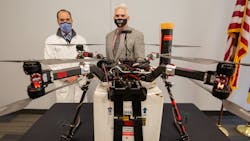University of Maryland Teams Honored for First Organ Transplant by Drone
Helicopter Association International (HAI) announced the University of Maryland UAS Test Site Team, led by director Matt Scassero, and University of Maryland Medical Center’s Dr. Joseph Scalea are the 2021 recipients of the association’s Golden Hour Award. The award recognizes the efforts of an individual, group, or organization that, through a particular activity or contributions over time, has advanced the use of helicopters or UAS aircraft in the vital mission of air medical transport.
On the night of Apr. 19, 2019, 44-year-old nursing assistant Trina Glispy waited at the University of Maryland Medical Center (UMMC), prepped for kidney transplant surgery. In her eighth year of dialysis for kidney failure, she had begun to lose hope. Destiny had another plan.
When Glispy learned she had a match, she was offered a very special opportunity — the kidney could be delivered to the hospital by drone, a medical first that would pave the way for faster organ delivery. Excited by the chance to make a difference, Glispy agreed to the delivery option.
As Glispy was prepped, an unmanned aircraft system (UAS) team, led by University of Maryland UAS Test Site Director Matt Scassero and UMMC Dr. Joseph Scalea, awaited the arrival of the kidney from the Living Legacy Foundation, Maryland’s organ procurement organization. Once secured, the kidney was launched in a custom UAS, complete with real-time monitoring equipment.
The drone flew 2.8 miles in 9.52 minutes at 300 ft. to the rooftop helipad at UMMC, faster than a car could have made the trip in Baltimore traffic. It landed smoothly with all organ-monitor readings in the green. The kidney was soon on its way to the operating room where Glispy waited.
The idea of organ transport by UAS was born two and a half years earlier. Scalea approached Scassero after hearing about a fixed-wing drone test his team had conducted carrying medical equipment across the Chesapeake Bay and asked if the same could be done for an organ.
Scassero’s team embraced the challenge. The drone was built from scratch with multiple redundancies all the way down to a parachute system that could be deployed either automatically or manually to protect the organ.
The team also designed the first-ever organ-monitoring system. The system tracks the state of the organ in transport in real time — recording and uploading temperature, pressure, and vibrations to the cloud for live monitoring. What’s more, upon landing, medical staff can remove the onboard SD memory card to review the same data.
“Nothing like this had ever been developed before,” Scassero says. “Currently, an organ is tested after harvest and then tested again after arrival to ensure it is still viable. With our monitoring system, we discovered the kidney we flew remained well within the parameters; I’d even say better than it would have in a car or helicopter. The hope is one day this monitoring technology will replace the need for that second biopsy.”
Glispy is doing very well and has returned to many of her former activities. The technology that made her recovery possible has also flourished. Members of the original team partnered with an investor to found MissionGO, a company that is developing and expanding this technology and increasing organ donation efficiency through a new software product.
True to the initiative that supported their research, the University of Maryland team is doing well.
HAI recognized previous recipients of the Salute to Excellence Awards through events at HAI Heli-Expo, the association’s annual trade show. Because of the pandemic, HAI is acknowledging the achievements of this year’s recipients through a variety of virtual events, including a series of webinars relevant to the subject of each award. Each individual recipient or team will also receive a trophy and publicity surrounding their work.





